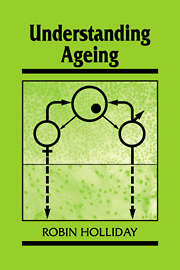Book contents
- Frontmatter
- Contents
- Preface
- Author's note
- Acknowledgements
- 1 Introduction
- 2 The evolved anatomical and physiological design of mammals
- 3 Maintenance of the adult organism
- 4 Theories of ageing
- 5 Cellular ageing
- 6 Genetic programmes for ageing
- 7 The evolution of longevity
- 8 Human disease and ageing
- 9 A better understanding of ageing
- Notes
- References
- Author index
- Subject index
1 - Introduction
Published online by Cambridge University Press: 31 March 2010
- Frontmatter
- Contents
- Preface
- Author's note
- Acknowledgements
- 1 Introduction
- 2 The evolved anatomical and physiological design of mammals
- 3 Maintenance of the adult organism
- 4 Theories of ageing
- 5 Cellular ageing
- 6 Genetic programmes for ageing
- 7 The evolution of longevity
- 8 Human disease and ageing
- 9 A better understanding of ageing
- Notes
- References
- Author index
- Subject index
Summary
The growth and reproduction of all organisms is dependent on a source of energy and other essential requirements from the environment. These resources for growth are never unlimited, from the simplest life forms to the most complex. Under good conditions, bacteria can divide every 30 minutes or so. From one cell 24 hours' growth produces 248 or 1016 cells, with a total mass of about 30 kilograms. It is obvious that in any natural environment such exponential growth cannot be sustained. In such an environment, cell division will continue until nutrients become limiting and cells enter what is generally referred to as ‘stationary phase’. There are different possible fates for such cells. They may die from prolonged starvation or dehydration, they may provide food for other organisms (such as nematodes, which feed on soil bacteria) or they may renew growth if a supply of energy and nutrients becomes available. Bacteria illustrate the general demographic principle that, for many environments, the number of a specific type of organism approximates to a steady state. In a given volume of soil, for example, the number of a particular species of bacteria may fluctuate between larger and smaller populations, but one can make the broad generalisation that numbers will remain roughly constant over quite long periods of time.
Darwin based his principle of natural selection on the fact that the reproductive potential of organisms can never be realised, but those that are better adapted to a particular environment use the resources more successfully and have increased reproductive fitness.
Information
- Type
- Chapter
- Information
- Understanding Ageing , pp. 1 - 11Publisher: Cambridge University PressPrint publication year: 1995
